B4U2 Ving 动名词作主语,宾语
- 格式:ppt
- 大小:1.44 MB
- 文档页数:38
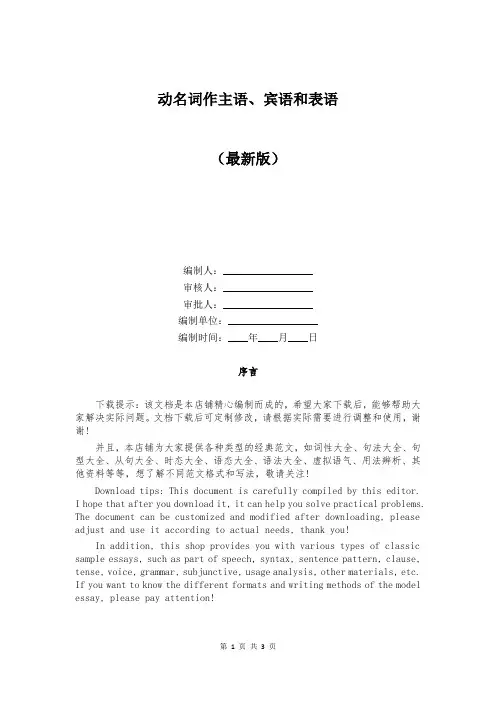
动名词作主语、宾语和表语(最新版)编制人:__________________审核人:__________________审批人:__________________编制单位:__________________编制时间:____年____月____日序言下载提示:该文档是本店铺精心编制而成的,希望大家下载后,能够帮助大家解决实际问题。
文档下载后可定制修改,请根据实际需要进行调整和使用,谢谢!并且,本店铺为大家提供各种类型的经典范文,如词性大全、句法大全、句型大全、从句大全、时态大全、语态大全、语法大全、虚拟语气、用法辨析、其他资料等等,想了解不同范文格式和写法,敬请关注!Download tips: This document is carefully compiled by this editor.I hope that after you download it, it can help you solve practical problems. The document can be customized and modified after downloading, please adjust and use it according to actual needs, thank you!In addition, this shop provides you with various types of classic sample essays, such as part of speech, syntax, sentence pattern, clause, tense, voice, grammar, subjunctive, usage analysis, other materials, etc. If you want to know the different formats and writing methods of the model essay, please pay attention!动名词作主语、宾语和表语1)作主语Fighting broke out between the South and the North.南方与北方开战了。
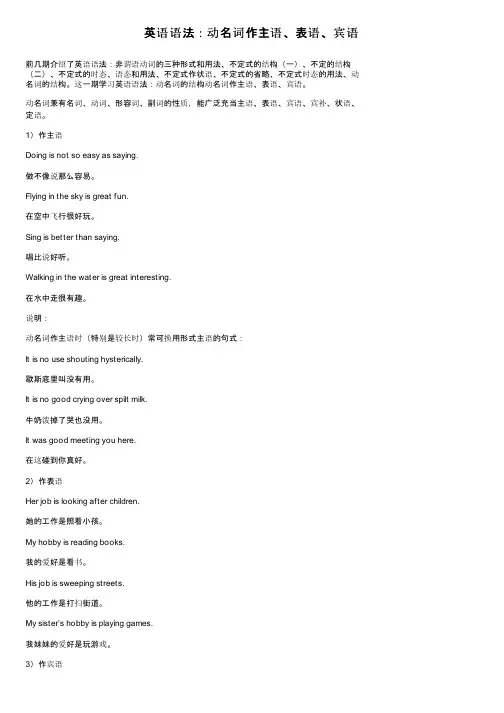
英语语法:动名词作主语、表语、宾语前几期介绍了英语语法:非谓语动词的三种形式和用法、不定式的结构(一)、不定的结构(二)、不定式的时态、语态和用法、不定式作状语、不定式的省略、不定式时态的用法、动名词的结构。
这一期学习英语语法:动名词的结构动名词作主语、表语、宾语。
动名词兼有名词、动词、形容词、副词的性质,能广泛充当主语、表语、宾语、宾补、状语、定语。
1)作主语Doing is not so easy as saying.做不像说那么容易。
Flying in the sky is great fun.在空中飞行很好玩。
Sing is better than saying.唱比说好听。
Walking in the water is great interesting.在水中走很有趣。
说明:动名词作主语时(特别是较长时)常可换用形式主语的句式:It is no use shouting hysterically.歇斯底里叫没有用。
It is no good crying over spilt milk.牛奶泼掉了哭也没用。
It was good meeting you here.在这碰到你真好。
2)作表语Her job is looking after children.她的工作是照看小孩。
My hobby is reading books.我的爱好是看书。
His job is sweeping streets.他的工作是打扫街道。
My sister’s hobby is playing games.我妹妹的爱好是玩游戏。
3)作宾语I enjoy singing.我喜欢唱歌。
He always avoids offending others.他总是避免冒犯别人。
My brother enjoys dancing disco.我弟弟喜欢调迪斯科。
She always advises saying quietly.她经常建议小声说话。


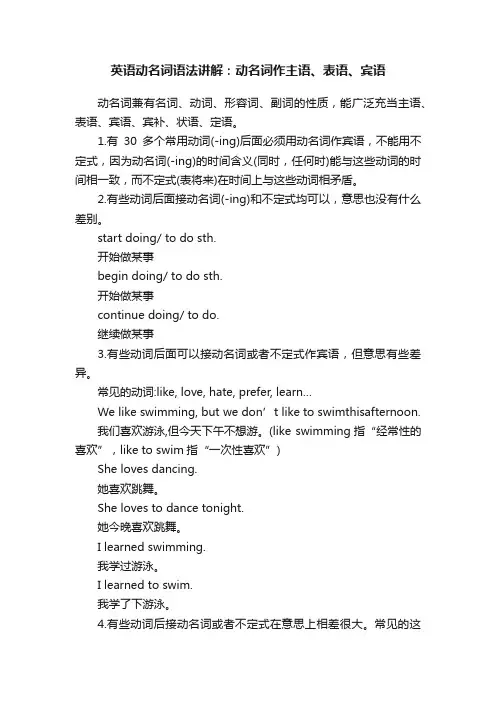
英语动名词语法讲解:动名词作主语、表语、宾语动名词兼有名词、动词、形容词、副词的性质,能广泛充当主语、表语、宾语、宾补、状语、定语。
1.有30多个常用动词(-ing)后面必须用动名词作宾语,不能用不定式,因为动名词(-ing)的时间含义(同时,任何时)能与这些动词的时间相一致,而不定式(表将来)在时间上与这些动词相矛盾。
2.有些动词后面接动名词(-ing)和不定式均可以,意思也没有什么差别。
start doing/ to do sth.开始做某事begin doing/ to do sth.开始做某事continue doing/ to do.继续做某事3.有些动词后面可以接动名词或者不定式作宾语,但意思有些差异。
常见的动词:like, love, hate, prefer, learn…We like swimming, but we don’t like to swimthisafternoon.我们喜欢游泳,但今天下午不想游。
(like swimming指“经常性的喜欢”,like to swim指“一次性喜欢”)She loves dancing.她喜欢跳舞。
She loves to dance tonight.她今晚喜欢跳舞。
I learned swimming.我学过游泳。
I learned to swim.我学了下游泳。
4.有些动词后接动名词或者不定式在意思上相差很大。
常见的这类动词有:remember, forget, regret…I remember posting the two parcels.我记得已寄走两个包裹。
(动名词表示过去)I remember to post the two parcels.我记得要寄两个包裹。
(不定式表示将来)He regrets offending three classmates.他后悔得罪了3个同学。
(已得罪)He regrets to offend three classmates.他很遗憾要得罪3个同学。
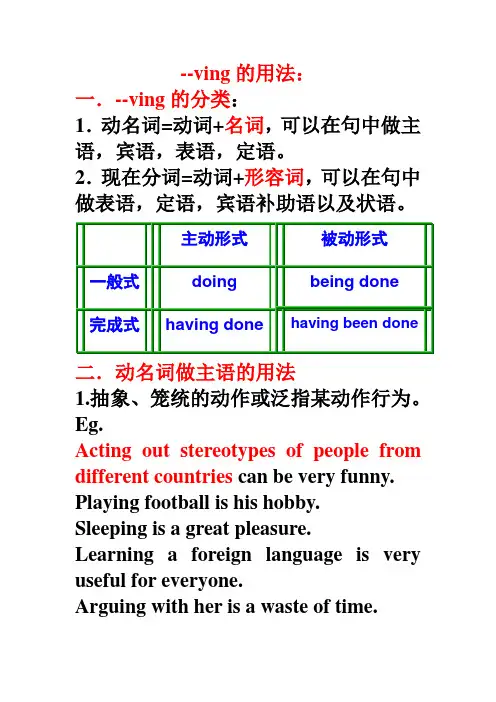
--ving的用法:一.--ving的分类:1.动名词=动词+名词,可以在句中做主语,宾语,表语,定语。
2.现在分词=动词+形容词,可以在句中做表语,定语,宾语补助语以及状语。
主动形式被动形式一般式doing being done完成式having done having been done二.动名词做主语的用法1.抽象、笼统的动作或泛指某动作行为。
Eg.Acting out stereotypes of people from different countries can be very funny. Playing football is his hobby.Sleeping is a great pleasure.Learning a foreign language is very useful for everyone.Arguing with her is a waste of time.2. 用it代替动名词做主语的情况,结构有:It is no use/ good/ fun/ a waste of time doing sth.It’s no use going there today; he won’t be there.It’s a waste of time arguing about it. 三.动名词做宾语的用法可以置于行为动词和介词后。
Eg.I suggested having a picnic. However, we didn’t reach an agreement.I have finished checking the homework. He is good at drawing.只能用动名词做宾语的动词及短语如下Advice, avoid, allow, appreciate, enjoy, escape, finish, dislike, imagine, mind, permit, practise, suggest, can’t help, give up, insist on, feel like, spend / waste time, have difficulty/ problem/ trouble doing sth, etc.在介词后面做宾语:devote to, look forward to, be fond of, prevent from, beengaged in(忙于), depend on,be/get/become used to等Need, want, require, be worth 后接动名词主动表示被动的含义,如:The room needs cleaning. = the room needs to be cleaned.The movie is worth seeing.有的动词尽管可以用两种结构,但意义明显不同,须认真加以区别:I forgot to close the door before I left the room.I forgot having closed the door.He tried to write better. (尽量努力地写) He tried writing with a brush. (用毛笔试着写)I couldn’t help finishing it. (不能不结束某事)I couldn’t help to finish it. (不能帮助结束某事)They left off fishing. (停止钓鱼)They left off to fish. (离开某处出发去钓鱼)I regret to say that there is no wine in the bottle. (对现在要发生的事表示遗憾、抱歉)I regret not taking your advice. (后悔) 四.动名词和现在分词做定语的用法。
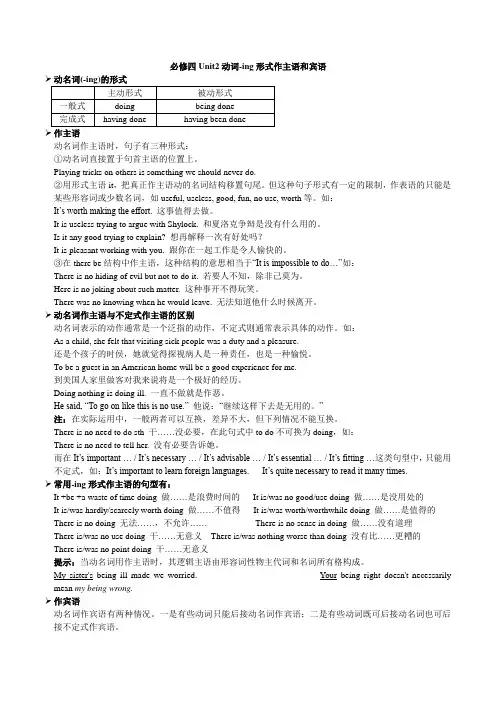
必修四Unit2动词-ing形式作主语和宾语动名词作主语时,句子有三种形式:①动名词直接置于句首主语的位置上。
Playing tricks on others is something we should never do.②用形式主语it,把真正作主语动的名词结构移置句尾。
但这种句子形式有一定的限制,作表语的只能是某些形容词或少数名词,如useful, useless, good, fun, no use, worth等。
如:It’s worth making the effort.这事值得去做。
It is useless trying to argue with Shylock. 和夏洛克争辩是没有什么用的。
Is it any good trying to explain? 想再解释一次有好处吗?It is pleasant working with you. 跟你在一起工作是令人愉快的。
③在there be结构中作主语,这种结构的意思相当于“It is impossible to do…”如:There is no hiding of evil but not to do it. 若要人不知,除非己莫为。
Here is no joking about such matter. 这种事开不得玩笑。
There was no knowing when he would leave. 无法知道他什么时候离开。
动名词作主语与不定式作主语的区别动名词表示的动作通常是一个泛指的动作,不定式则通常表示具体的动作。
如:As a child, she felt that visiting sick people was a duty and a pleasure.还是个孩子的时侯,她就觉得探视病人是一种责任,也是一种愉悦。
To be a guest in an American home will be a good experience for me.到美国人家里做客对我来说将是一个极好的经历。
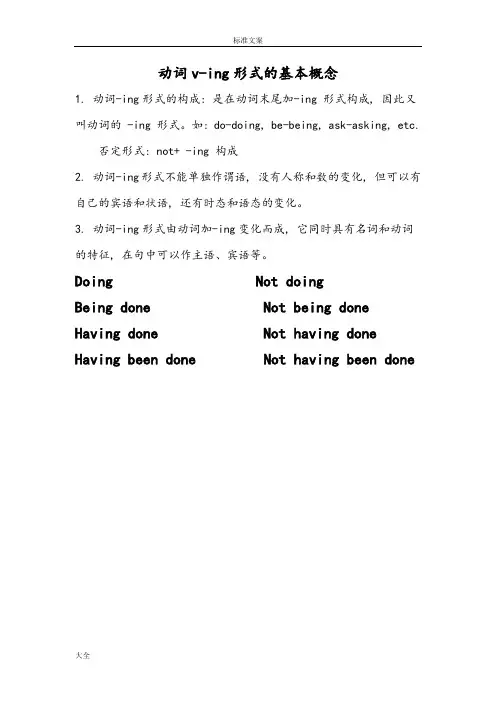
动词v-ing形式的基本概念1. 动词-ing形式的构成: 是在动词末尾加-ing 形式构成, 因此又叫动词的 -ing 形式。
如: do-doing, be-being, ask-asking, etc.否定形式: not+ -ing 构成2. 动词-ing形式不能单独作谓语, 没有人称和数的变化, 但可以有自己的宾语和状语, 还有时态和语态的变化。
3. 动词-ing形式由动词加-ing变化而成, 它同时具有名词和动词的特征, 在句中可以作主语、宾语等。
Doing Not doingBeing done Not being done Having done Not having done Having been done Not having been doneBook4 Unit2 动词-ing形式作主语和宾语I. 动词v-ing形式做主语1. 动词v-ing形式可直接置于句首作主语。
表示经常的、习惯性的动作或状态, 谓语动词通常用单数。
如:①Walking is a good form of exercise for both young and old.②Watching news on TV has become aroutine(日常习惯) for me.③Learning about a language is easier than using it.2. 为了保持句子平衡,通常用先行词it作形式主语,而把真正的主语放在句末,可以作表语的只能是某些形容词或少数名词,如useful,useless, good, fun, no use, worthwhile等①It is no use crying over spilt milk.作无益的后悔是没有用的。
②It is useless trying to argue(争辩) with Shylock(夏洛克,人名).③It’s fun jumping into cool water in hot summer.④It’s good using your head often.3. 动词-ing形式作主语的常用it作形式主语的句型有:①It +be +a waste(浪费) of time doing 做……是浪费时间的②It is/was no good/use doing 做……是没用处的③It is/was worth/worthwhile doing 做……是值得的④There is/was no point(意义) doing干…无意义⑤There is no sense in doing 做…没有道理⑥It is/was hardly/scarcely worth doing 做……不值得There is no doing 无法……; 不允许……There is/was no use doing 干…无意义There is/was nothing worse than doing 没有比…更糟的e.g.①There was no knowing where we would go. 我们不知道要去哪儿。
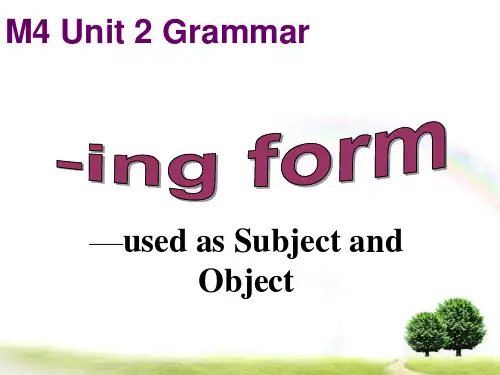
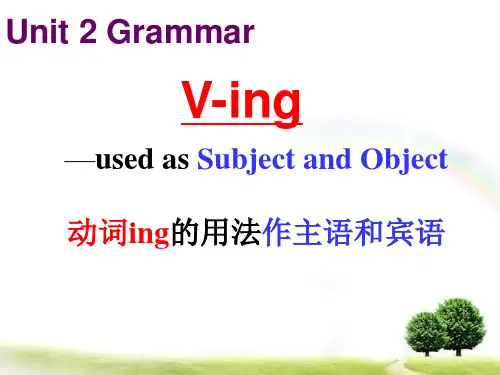
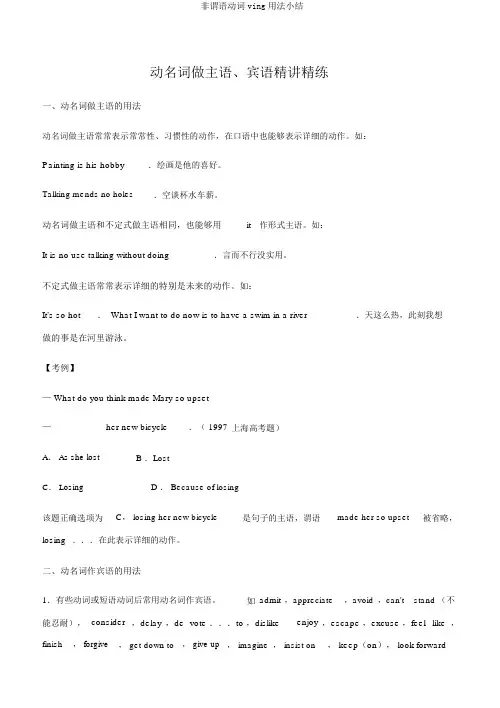
动名词做主语、宾语精讲精练一、动名词做主语的用法动名词做主语常常表示常常性、习惯性的动作,在口语中也能够表示详细的动作。
如:Painting is his hobby.绘画是他的喜好。
Talking mends no holes.空谈杯水车薪。
动名词做主语和不定式做主语相同,也能够用it作形式主语。
如:It is no use talking without doing.言而不行没实用。
不定式做主语常常表示详细的特别是未来的动作。
如:It's so hot.What I want to do now is to have a swim in a river.天这么热,此刻我想做的事是在河里游泳。
【考例】— What do you think made Mary so upset— __________ her new bicycle.( 1997上海高考题)A. As she lost B .LostC. Losing D . Because of losing该题正确选项为C, losing her new bicycle是句子的主语,谓语made her so upset被省略,losing...在此表示详细的动作。
二、动名词作宾语的用法1.有些动词或短语动词后常用动名词作宾语。
如admit,appreciate,avoid,can't stand (不能忍耐),consider,delay,de- vote ...to ,dislike enjoy,escape ,excuse ,feel like ,finish, forgive, get down to, give up, imagine, insist on, keep(on), look forwardto ,mention ,mind,miss(错过),pay attention to ,practice, put off ,stick to ,suggest等等。